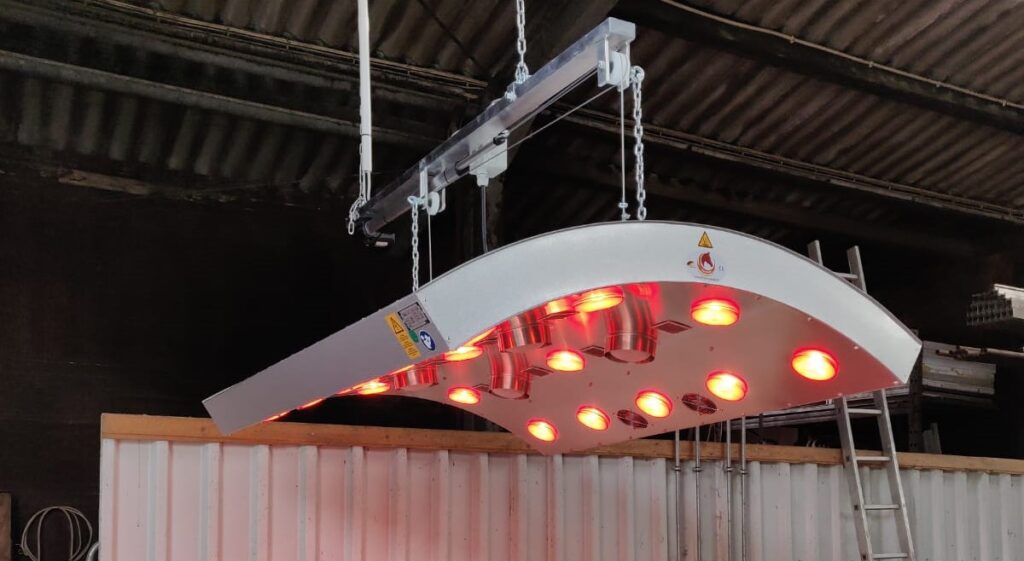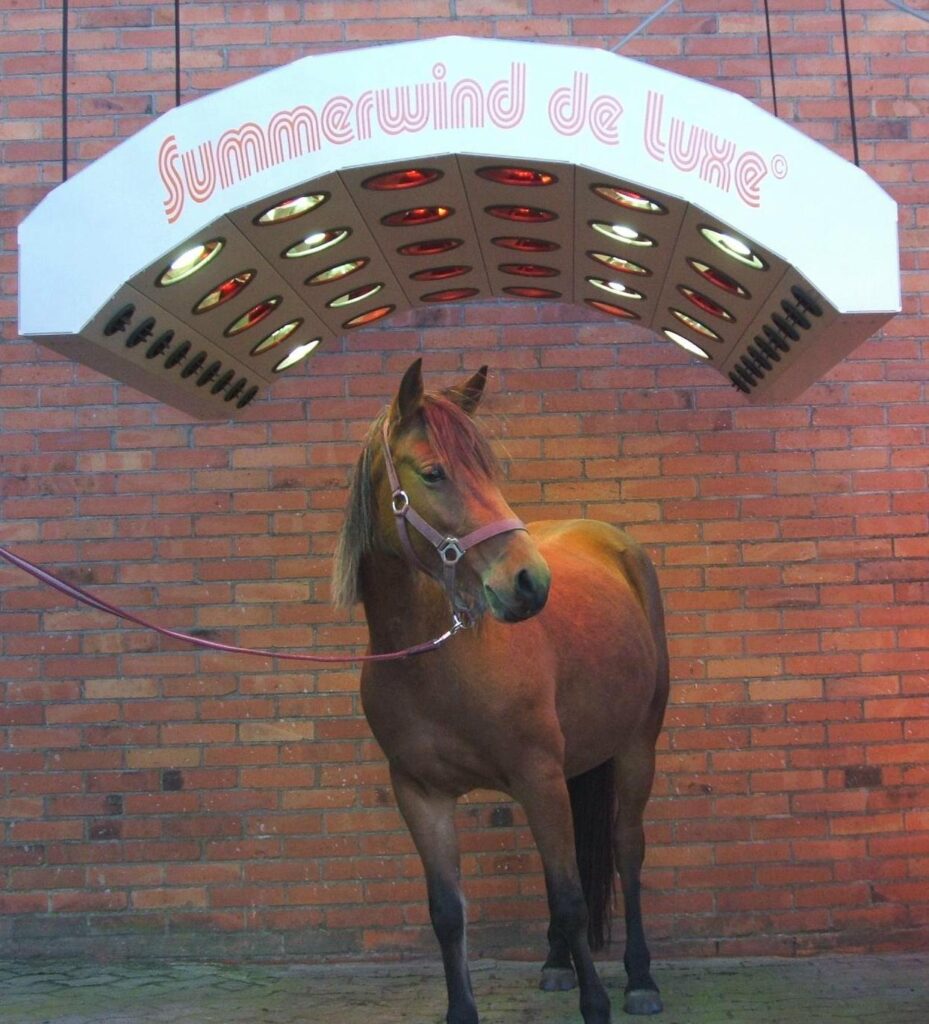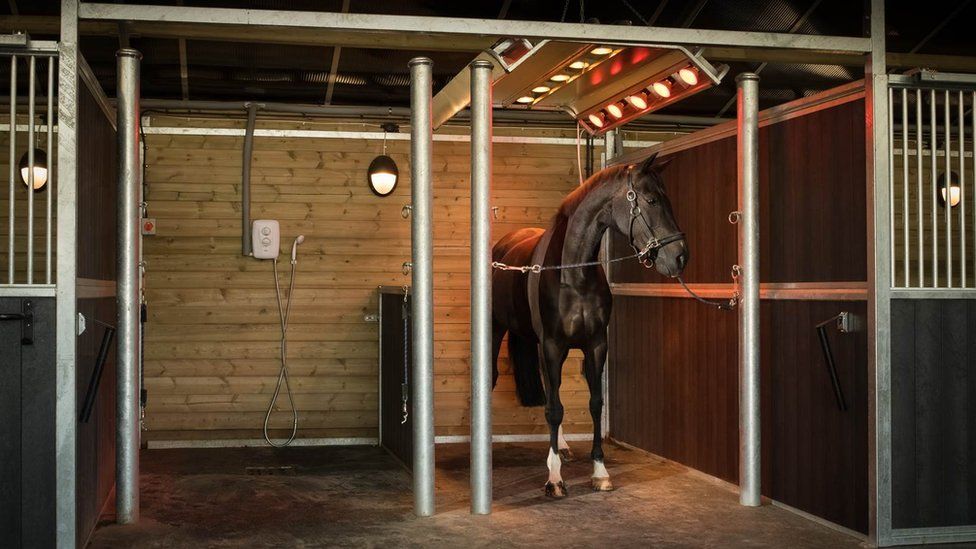A solarium for a horse is a system of infrared lamps that give off heat and light to the horse. It is used to warm up the horse’s muscles before exercise and dry the horse after washing. It improves the horse’s health and well-being. A solarium can also help with healing injuries, reducing inflammation, and enhancing the horse’s coat.
Check out our post on Horse Trailer Roadside Assistance
https://helloequine.com/horse-trailer-roadside-assistance-full-guide/
What are the benefits of using a solarium?
Some of the benefits of using a solarium for a horse are:
- It increases blood circulation and oxygen delivery to the cells, which promotes muscle and tissue growth.
- Relaxes the horse and reduces stress and tension.
- Prevents soreness and stiffness by expelling lactic acid from the muscles.
- Boosts the immune system by increasing white blood cells and vitamin D production.
- It accelerates the shedding process and gives the horse a shiny and healthy coat.
A solarium consists of a canopy with infrared lamps that can be adjusted to different heights and angles. The lamps emit short-wave infrared light, which penetrates the skin and warms the muscles. The solarium can be controlled by a timer or a remote, and some models have fans, speakers, or aromatherapy features. The solarium should be installed in a safe and secure place, and the horse should be supervised while using it. The recommended duration and frequency of using a solarium depends on the horse’s condition and needs. But generally, it is advised to use it for 10 to 20 minutes before and after exercise.
What is the best time to use a solarium?
The best time to use a solarium for a horse depends on the purpose and the condition of the horse. Generally, a solarium can be used before and after exercise, as well as for drying and grooming. Here are some guidelines for using a solarium for different situations:
Before exercise: A solarium can help to warm up the horse’s muscles and prepare them for physical activity. This can prevent injuries and improve performance. It is recommended to use the solarium for 10 to 20 minutes before riding, depending on the horse’s needs and the weather. The solarium should be set to a moderate temperature and the horse should be relaxed and comfortable.
After exercise: A solarium can help to cool down the horse’s muscles and eliminate lactic acid buildup. This can reduce stiffness and soreness and promote recovery and healing. The solarium should be set to a low temperature and the horse should be hydrated and ventilated.
Drying: A solarium can help to dry the horse quickly and thoroughly after washing or training in wet or damp conditions. This can prevent skin problems and infections and keep the horse healthy and comfortable. It is recommended to use the solarium for 15 to 30 minutes for drying, depending on the horse’s coat and whether he has been clipped. The solarium should be set to a high temperature and the horse should be monitored for signs of overheating.
Grooming: A solarium can help to improve the horse’s coat and skin condition by stimulating blood circulation and vitamin D production. This can give the horse a shiny and healthy coat and boost the immune system. It is recommended to use the solarium for 8 to 60 minutes for grooming, depending on the horse’s needs and the type of light therapy. The solarium should be set to a suitable temperature and the horse should wear protective goggles or a fly mask if the solarium emits UV light.

How do I choose a right solarium for my horse?
Choosing a right solarium for your horse depends on several factors, such as your horse’s needs, your budget, your space, and your preferences. Here are some tips to help you make the best decision:
- Consider the purpose of using a solarium. Do you want to use it for warming up, cooling down, drying, grooming, or healing your horse? Different solariums may have different features and benefits for each purpose. For example, some solariums may have UV light, LED-RGB light, or infrared light, which can affect your horse’s skin, coat, eyes, muscles, and immune system in different ways.
- You want to choose a solarium that can cover your horse’s body evenly and comfortably, without being too close or too far. Some solariums may have adjustable heights and angles, which can help you customize the fit for your horse. You also want to make sure that the solarium has enough bulbs and power to provide sufficient heat and light for your horse.
- Consider the installation and maintenance of the solarium. You want to choose a solarium that is easy to install and use, and that does not require frequent repairs or replacements. You also want to check the safety and quality of the solarium, such as the wiring, the canopy, the bulbs, the thermostat, the timer, and the switch. Also consult with a qualified electrician and follow the manufacturer’s instructions for installation and maintenance.
- Consider the cost and value of the solarium. Choose a solarium that fits your budget and offers the best value for your money. You should compare the prices and features of different solariums and read the reviews and testimonials of other users. You should also consider the long-term benefits and savings of using a solarium, such as reducing vet bills, improving performance, and enhancing well-being.
Choosing a right solarium for your horse can be a challenging task, but it can also be a rewarding investment. By following these tips, you can find the best solarium for your horse and enjoy the many benefits of light therapy.
Check out our post on Horse Trailer Coverage
https://helloequine.com/horse-trailer-coverage-a-complete-guide/
How do I know if my horse likes using a solarium?
To know if your horse likes using a solarium, you can observe his behavior and body language while he is under the solarium. Some signs that your horse enjoys the solarium are:
- Calm and relaxed, and does not show signs of stress or agitation, such as pawing, kicking, biting, or head tossing.
- Lowers his head and neck, and closes his eyes, indicating that he is comfortable and content.
- Sighs, yawns, or licks his lips, indicating that he is releasing tension and relaxing his muscles.
- Stretches his legs, back, or neck, indicating that he is warming up and loosening his joints.
- Sweats lightly, indicating that he is getting enough heat and stimulation from the solarium.
Some signs that your horse does not like the solarium are:
- Restless and nervous, and shows signs of anxiety or fear, such as snorting, shaking, or sweating profusely.
- Raises his head and neck, and opens his eyes wide, indicating that he is alert and wary.
- Pins his ears, shows his teeth, or swishes his tail, indicating that he is annoyed or angry.
- Tries to escape, resist, or avoid the solarium, indicating that he is uncomfortable or in pain.
- Does not sweat at all, indicating that he is not getting enough heat or stimulation from the solarium.
If your horse does not like the solarium, you should try to find out the reason and adjust the settings or the duration of the session accordingly. You should also consult with your veterinarian and follow their recommendations. Some possible reasons why your horse may not like the solarium are:
- The solarium is too hot or too cold for your horse, and he feels overheated or chilled.
- It is too close or too far from your horse, and he feels burned or neglected.
- Emits UV light, and your horse has sensitive eyes or skin.
- The solarium is new or unfamiliar to your horse, and he needs time to get used to it.
- Solarium is noisy or smelly, and your horse is distracted or bothered by it.
Using a solarium for your horse can have many benefits, but it also requires caution and care. By observing your horse’s reactions and preferences, you can make the solarium experience enjoyable and effective for both of you.

Are there any risks associated with using a solarium?
There are some potential risks associated with using a solarium for a horse. But they can be minimized by following proper guidelines and precautions. Some of the risks are:
Overheating: If the solarium is too hot or used for too long, the horse may overheat and suffer from dehydration, heat stress. This can cause damage to the horse’s organs, nervous system, and skin. To prevent overheating, the horse should have access to fresh water and ventilation. The solarium should have a thermostat and a timer to regulate the temperature and duration of the session. The horse should also be monitored for signs of discomfort, such as sweating, panting, restlessness, or agitation.
Burns: If the solarium is too close to the horse or the horse touches the lamps, the horse may get burned by the infrared light. This can cause pain, inflammation, and infection. To prevent burns, the solarium should have a protective canopy and a safety switch to turn off the lamps in case of contact. The solarium should also be adjusted to the appropriate height and angle for the horse’s size and shape. The horse should be secured with a halter and a lead rope, and not left unattended while using the solarium.
Eye damage: If the solarium emits ultraviolet (UV) light, the horse may suffer from eye damage, such as cataracts, corneal ulcers, or blindness. UV light can also cause skin cancer and sunburn. To prevent eye damage, the solarium should have filters or shields to block out UV rays or use lamps that do not emit UV light. The horse should also wear protective goggles or a fly mask while using the solarium.
Electrical hazards: If the solarium is not installed or maintained properly, the horse may be exposed to electrical hazards, such as shocks, sparks, or fires. This can cause injury or death to the horse and the handler. To prevent electrical hazards, the solarium should be installed by a qualified electrician and checked regularly for any faults or damages. The solarium should also be plugged into a grounded outlet and protected by a circuit breaker or a fuse. The solarium should not be used in wet or humid conditions, or near flammable materials.
Using a solarium for a horse can have many benefits, but it also requires caution and care. By following the manufacturer’s instructions and the veterinarian’s advice, the horse owner can ensure that the solarium is used safely and effectively.
Can a horse use a solarium if he has health problems?
A solarium can be beneficial for a horse with health problems, depending on the type and severity of the problem. A solarium can help with healing injuries, reducing inflammation, and enhancing the immune system by increasing blood circulation, oxygen delivery, and vitamin D production. However, a solarium should not be used for a horse with certain conditions, such as:
Fever: A horse with a fever should not be exposed to additional heat, as this can worsen the condition and cause dehydration or heat stroke. A horse with a fever should be kept in a cool and well-ventilated place and given plenty of water and electrolytes.
Skin problems: A horse with skin problems, such as wounds, infections, allergies, or sunburn, should not be exposed to infrared light. This can irritate the skin and cause pain or infection. A horse with skin problems should be treated with appropriate medication and protection and kept away from direct sunlight or UV rays.
Eye problems: A horse with eye problems, such as cataracts, corneal ulcers, or blindness, should not be exposed to UV light. This can damage the eyes and cause vision loss. A horse with eye problems should be treated with appropriate medication and protection. Wear protective goggles or a fly mask if using a solarium that emits UV light.
Before using a solarium for a horse with health problems, it is advisable to consult with a veterinarian and follow their recommendations.
